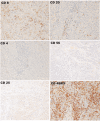Possible significance of differences in proportions of cytotoxic T cells and B-lineage cells in the tumour-infiltrating lymphocytes of typical and atypical medullary carcinomas of the breast
- PMID: 20092246
- PMCID: PMC2964018
Possible significance of differences in proportions of cytotoxic T cells and B-lineage cells in the tumour-infiltrating lymphocytes of typical and atypical medullary carcinomas of the breast
Abstract
Medullary carcinoma (MC) of the breast is a high grade carcinoma that has a relatively favourable prognosis compared to atypical medullary carcinoma (AMC) and other more common breast carcinomas. In a retrospective study in Brunei Darussalam of all available biopsy samples, we compared the nature of the tumour-infiltrating lymphocytes (TILs) in MC and AMC in relation to recorded tumour characteristics. CD4, CD8, CD20, CD25, CD45RO, and CD56 and common tumour biomarkers were detected immunohistochemically. The 11 cases of MC had no nodal metastases and survived without relapse, suggesting good tumour control. In contrast, 7 cases of nodal metastases and 1 relapse were observed in 12 AMCs. Although not statistically significant, there was a tendency for a greater proportion of AMCs to express the Her2/neu oncogene. Higher proportions of CD45RO+ and CD8+ cells, and lower levels of CD20+ cells, were characteristic of TILs in MC compared to AMC. The ratio of CTL to B-lineage cells in TILs in both tumours considered together was inversely related to the expression of HER2/neu and the presence of nodal metastases. The findings suggest that CTLs, rather than antibodies, may give better tumour control in MC relative to AMC. We propose that a comparison of the cellular, molecular and immunological characteristics of MC and AMC, as a paired model system, in a multi-centre investigation with a much larger number of samples will be valuable for better understanding mechanisms of tumour immunity.
Figures
Similar articles
-
Cytotoxic phenotype of tumor infiltrating lymphocytes in medullary carcinoma of the breast.Mod Pathol. 1999 Nov;12(11):1050-6. Mod Pathol. 1999. PMID: 10574602
-
Immunophenotypic profile of tumor infiltrating lymphocytes in medullary carcinoma of the breast.Eur J Gynaecol Oncol. 2002;23(5):433-6. Eur J Gynaecol Oncol. 2002. PMID: 12440819
-
Diagnostic significance of intratumoral CD8+ tumor-infiltrating lymphocytes in medullary carcinoma.Hum Pathol. 2017 Dec;70:129-138. doi: 10.1016/j.humpath.2017.10.020. Epub 2017 Nov 6. Hum Pathol. 2017. PMID: 29122657
-
Differential amplification and overexpression of HER-2/neu, p53, MIB1, and estrogen receptor/progesterone receptor among medullary carcinoma, atypical medullary carcinoma, and high-grade invasive ductal carcinoma of breast.Arch Pathol Lab Med. 2003 Nov;127(11):1458-64. doi: 10.5858/2003-127-1458-DAAOON. Arch Pathol Lab Med. 2003. PMID: 14567723
-
Oncogene addiction and immunity: clinical implications of tumour infiltrating lymphocytes in breast cancers overexpressing the HER2/neu oncogene.Curr Opin Oncol. 2014 Nov;26(6):562-7. doi: 10.1097/CCO.0000000000000131. Curr Opin Oncol. 2014. PMID: 25188474 Review.
Cited by
-
Differential pattern and prognostic significance of CD4+, FOXP3+ and IL-17+ tumor infiltrating lymphocytes in ductal and lobular breast cancers.BMC Cancer. 2012 Apr 3;12:134. doi: 10.1186/1471-2407-12-134. BMC Cancer. 2012. PMID: 22471961 Free PMC article.
-
The Multifaceted Nature of Tumor Microenvironment in Breast Carcinomas.Pathobiology. 2020;87(2):125-142. doi: 10.1159/000507055. Epub 2020 Apr 23. Pathobiology. 2020. PMID: 32325459 Free PMC article. Review.
-
Invasive Breast Carcinoma of No Special Type with Medullary Pattern: Morphological and Immunohistochemical Features.Turk Patoloji Derg. 2022;38(3):205-212. doi: 10.5146/tjpath.2021.01559. Turk Patoloji Derg. 2022. PMID: 34636027 Free PMC article.
-
The impact of the immune system on tumor: angiogenesis and vascular remodeling.Front Oncol. 2014 Apr 8;4:69. doi: 10.3389/fonc.2014.00069. eCollection 2014. Front Oncol. 2014. PMID: 24782982 Free PMC article. Review.
-
Influence of human immune cells on cancer: studies at the University of Colorado.Immunol Res. 2013 Mar;55(1-3):22-33. doi: 10.1007/s12026-012-8346-y. Immunol Res. 2013. PMID: 22941561 Free PMC article. Review.
References
-
- Ridolfi RL, Rosen PP, Port A, Kinne D, Mike V. Medullary carcinoma of the breast: a clinicopathologic study with a 10-year follow up. Cancer. 1977;40:1365–1385. - PubMed
-
- Sternberg SS, Antonioli DA, Carter D, Mills SE, Oberman HA, editors. Philadelphia (PA): Lippincott Williams & Wilkins; 1999. Diagnostic Surgical Pathology. (Eds.) 3rd edition.
-
- Jensen ML, Kiaer H, Andersen J, Jensen V, Melsen F. Prognostic comparison of three classifications for medullary carcinomas of the breast. Histopathology. 1997;30:523–532. - PubMed
-
- Pedersen L, Zedeler K, Holck S, Schiødt T, Mouridsen HT. Medullary carcinoma of the breast. Prevalence and prognostic importance of classical risk factors in breast cancer. Eur J Cancer. 1995;31:2289–2295. - PubMed
-
- Wargotz ES, Silverberg SG. Medullary carcinoma of the breast: a clinicopathologic study with appraisal of current diagnostic criteria. Human Pathol. 1988;19:1340–1346. - PubMed
MeSH terms
Substances
LinkOut - more resources
Full Text Sources
Medical
Research Materials
Miscellaneous



